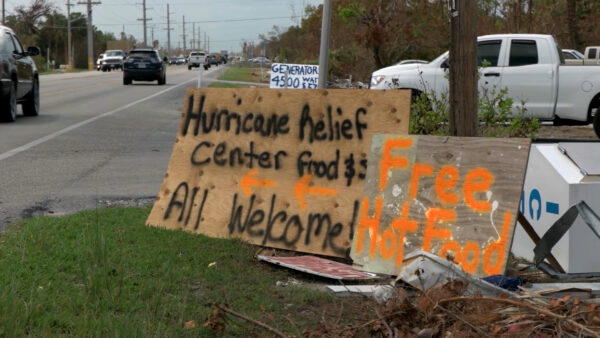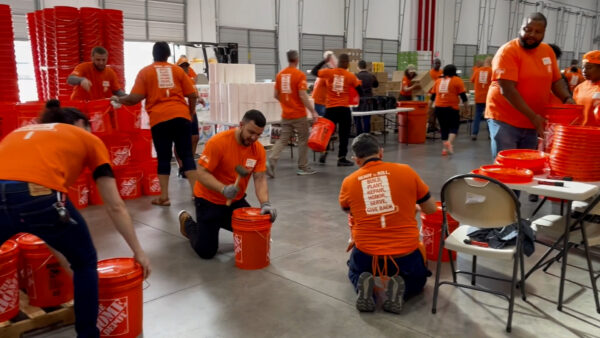The Home Depot made an employee-focused documentary. Here’s what they learned.
Ragan spoke with Lou Dubois from The Home Depot about the company’s employee-focused approach to making its first documentary about rebuilding communities after natural disasters.

The Home Depot recently premiered its first-ever documentary, “Hope Builds,” at a makeshift theatre constructed in a lumber aisle at a store in Joplin, Missouri. This decision was not random — the 17-minute-film tells the story of the company’s history of helping rebuild communities after natural disasters, and this Joplin location replaced a former location that was torn apart by a tornado that hit the town in 2011, killing 161 people and devastating the community.
Several associates from the original Joplin store were on hand for the premiere, and some are also featured in the documentary. More than a story about how associates came together during times of unprecedented destruction and chaos, “Hope Builds” illustrates how The Home Depot community understands its sense of service to help the wider community at large rebuild.
Dubois acknowledged the massive contributions that “Hope Builds” Director Jessica Dimmock, whose work focuses on humanistic and intimate storytelling, made to the project. He also emphasized the guiding experience of production partners at Imagine Entertainment, agency partners at BBDO, marketing leadership by Marshall Weiss and Dan Brandt, and the insights of Creative Director Briar Waterman, to name a few.
Of course, the film would not exist without the associates whose honest, vulnerable stories shape its narrative. To that end, Dubois shared some tips for how to best work with employees when documenting their story.
Show, don’t tell, your values,
A foundational tenet of impactful storytelling, “show, don’t tell” means that the ideas you want to hammer home in your story should be conveyed through action, not exposition.

And while the prospect of a documentary highlighting your organization’s crisis response can very quickly turn opportunistic if certain sensitivities aren’t properly considered, The Home Depot’s film lets the sincerity of its employees speak for them.
When one associate is asked why she’s helping residents following a natural disaster, she says, without missing a beat, “Because I still have a home and these people don’t.”
It’s one of many powerful pieces of archival footage captured in the documentary, which is made more impactful by including this candid footage of associates responding to disasters of yore.
At another point, an associate delivers a powerful line over archival footage of associates rebuilding — “When things are at their worst, we’re at our best.”
“Ultimately, we view our role not just to sell you products, but to be good community members wherever we operate,” Dubois said, “and you find people with those values every day. And I think that everyone in the film really is an embodiment of that in many regards, a great bridge to that cultural piece.”
Organize and seek releases for employee footage as you collect it.
As this documentary was coming together, Dubois explained, the project team was fortunate to have an organized archival system to work with. Back in 1987, an internal entity called Home Depot Television was started to tell employee stories, and from an early date, archives were kept at the company’s Atlanta headquarters.
Whether or not your organization has such a system, it’s not too late to start organizing and cataloging as you collect footage. You may not use it right away, but it can become critical down the line.

Perhaps most importantly, be sure to get releases signed by employees and others as filming occurs. “We have an extensive release process on almost all of our archived video content,” explained Dubois, “so we know what we have the right to use. It’s a blessing that we’ve had this function around for almost 35 years now.”
This system made it much easier for the documentary team to know what assets it had to work with and is a reminder that you don’t always have to start from scratch when trying to envision what footage you would include in a potential documentary about your organization.
“Archiving, logging and categorizing video is critical,” added Dubois, “because you never know when you’re going to use it again. I feel strongly that this is something most companies underinvest in.”
Embrace a clear narrative intention to communicate your authenticity.
These disasters didn’t just impact the external audiences, but the whole community. As the Joplin tornado destroyed the local Home Depot, several associates were injured and left without homes. Tragically, seven people lost their lives, including one associate.
Hence, this film needed to strike a delicate balance in tone that was simultaneously sensitive and mindful of employees while still celebrating the brand’s evolution of disaster response efforts.
“It’s a balance, between brand and performative,” Dubois said, “between how you tell that story without making it about sales and transactions and things of that nature. It was a very clear intention we had in the beginning that was not what we were trying to drive with this.”

Dubois said that this intention was clear because disaster relief was simultaneously central to The Home Depot’s philanthropic effort in each community they serve and who they are as a brand.
Starting from that place allowed for the documentary’s premiere in Joplin to be a doubly cathartic experience, as Dubois and his colleagues drove around town, went to the disaster memorial, hosted the mayor, police chief, former and current store associates and other local heroes at the premiere.
“It was very clear as we talked to all of those people how big of a deal The Home Depot plays in these communities outside of this documentary,” he said. “And that’s what we tried to bring through with the messaging.”
Interview more employees than you need and keep those that serve the story.
The Home Depot made a conscious decision not to feature a narrator for this documentary, understanding that a film about its associates and culture is more impactful when they drive the narrative forward. The Home Depot featured eight associates throughout the film, culled from more than 110 interviews with associates and community members. All the more remarkable, Dubois emphasized that The Home Depot did not media train the associates who went on camera.
“This was just who they are,” he said. “It was a culling process, but it was more based on the story than how they were on camera.”

Dubois gives immense credit to director Dimmock for focusing on employees who could push the story forward in lieu of having a narrator. “From a creative process POV this is really critical to call out,” he said. “We wanted those voices that we use throughout to be the narrators, and ultimately, that helped us to decide independently who was right as Jess and team put the film together.”
Release internally first.
While Dubois and his team felt confident that this subject matter truly deserved the long-form treatment, they also wanted to be sure associates felt good about it. To ensure those channels were open, the film was pre-released internally via the company’s intranet and Yammer platform, and employees were encouraged to give feedback, which many did quickly.
“It was really critical for us that we get this film in front of employees before we even thought about what we were going to do externally and frankly, before we even started this project,” Dubois said, explaining that in early conversations they settled on the idea that it would still be worthwhile even if it was only released internally.
“We wanted to be conscious of the environment that we lived in,” he added, “and it’s a tough thing as a brand to figure out where you fit into that ecosystem of information that’s going around right now.”
Dubois said that this month felt like the right time, but acknowledged that the time for such a film is never perfect so long as there are continuous natural disasters in places like California, where there had recently been three mudslides over the course of three days, tornadoes in Alabama and more.
“The point of this too was that disasters are not going to stop coming,” he said. “They’re going to keep coming harder, faster, bigger and more than ever before. And we as a company, as individuals, as humans, we have a responsibility to help the people around us that are in need.”
All images provided courtesy of The Home Depot.
Justin Joffe is the editor-in-chief of Ragan Communications. Outside of Ragan he is also a media and culture writer, an avid music nerd, cinephile, and musician whose recorded output ranges from ambient and experimental to folk and rock’n’roll. Follow him on Twitter and LinkedIn.







